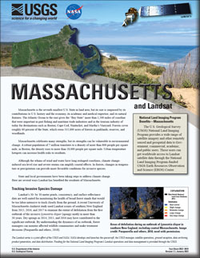Massachusetts and Landsat
Links
- Document: Report (7.65 MB pdf) , HTML , XML
- Version History: Version History (1.86 kB txt)
- Download citation as: RIS | Dublin Core
Abstract
Massachusetts is the seventh smallest U.S. State in land area, but its size is surpassed by its contributions to U.S. history and the economy, its academic and medical expertise, and its natural features. The Atlantic Ocean to the east gives the “Bay State” more than 1,500 miles of coastline that were important in past fishing and maritime trade industries and in the tourism industry of today for destinations such as Boston, Cape Cod, Nantucket, and Martha’s Vineyard. Forests cover roughly 60 percent of the State, which owns 315,000 acres of forests in parklands, reserves, and woodlands.
Massachusetts celebrates many strengths, but its strengths can be vulnerable to environmental change. A robust population of 7 million translates to a density of more than 800 people per square mile; in Boston, the density rises to more than 18,000 people per square mile. Urban temperature hotspots can increase health risks to residents.
Although the whims of wind and water have long reshaped coastlines, climate change-induced sea-level rise and severe storms can amplify coastal effects. In forests, changes in temperature or precipitation can provide more favorable conditions for invasive species.
State and local governments have been taking steps to address climate change. Here are several ways Landsat has benefited the residents of Massachusetts.
Suggested Citation
U.S. Geological Survey, 2022, Massachusetts and Landsat (ver. 1.1, January 2023): U.S. Geological Survey Fact Sheet 2022–3018, 2 p., https://doi.org/10.3133/fs20223018.
ISSN: 2327-6932 (online)
ISSN: 2327-6916 (print)
Study Area
Table of Contents
- Tracking Invasive Species Damage
- Developing a Decarbonization Plan
- Identifying City Hotspots
- Viewing Coastal Changes
- Landsat—Critical Information Infrastructure for the Nation
- References Cited
| Publication type | Report |
|---|---|
| Publication Subtype | USGS Numbered Series |
| Title | Massachusetts and Landsat |
| Series title | Fact Sheet |
| Series number | 2022-3018 |
| DOI | 10.3133/fs20223018 |
| Edition | Version 1.0: March 24, 2022; Version 1.1: January 23, 2023 |
| Publication Date | March 24, 2022 |
| Year Published | 2022 |
| Language | English |
| Publisher | U.S. Geological Survey |
| Publisher location | Reston, VA |
| Contributing office(s) | Earth Resources Observation and Science (EROS) Center |
| Description | 2 p. |
| Country | United States |
| State | Massachusetts |
| Online Only (Y/N) | N |


